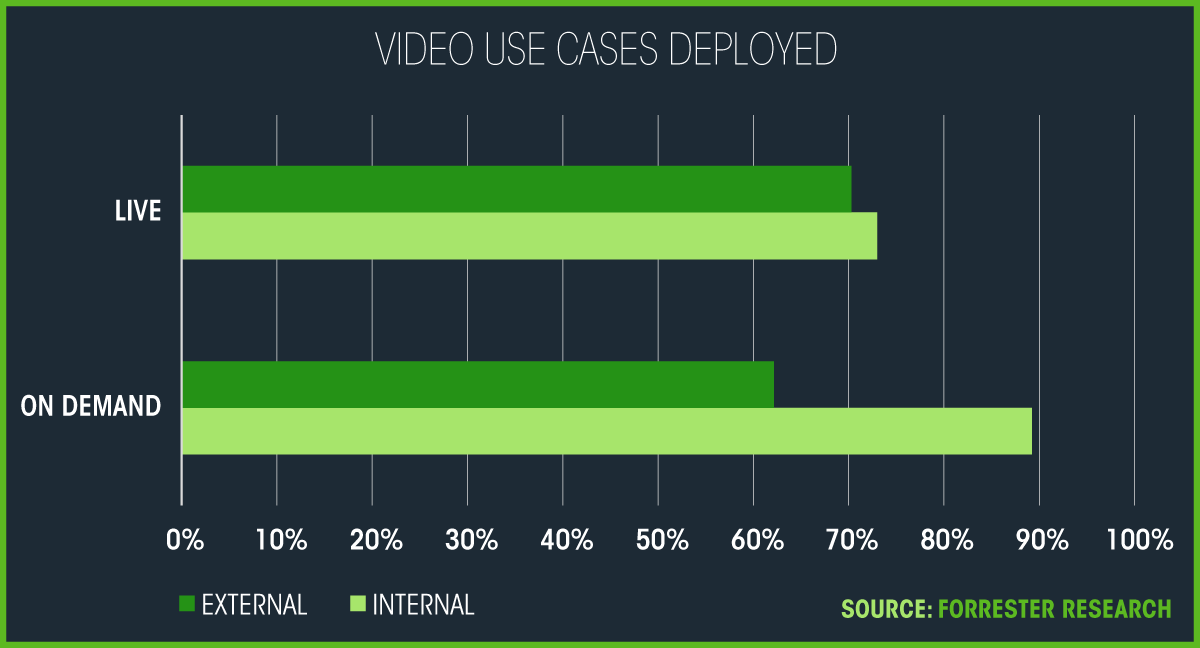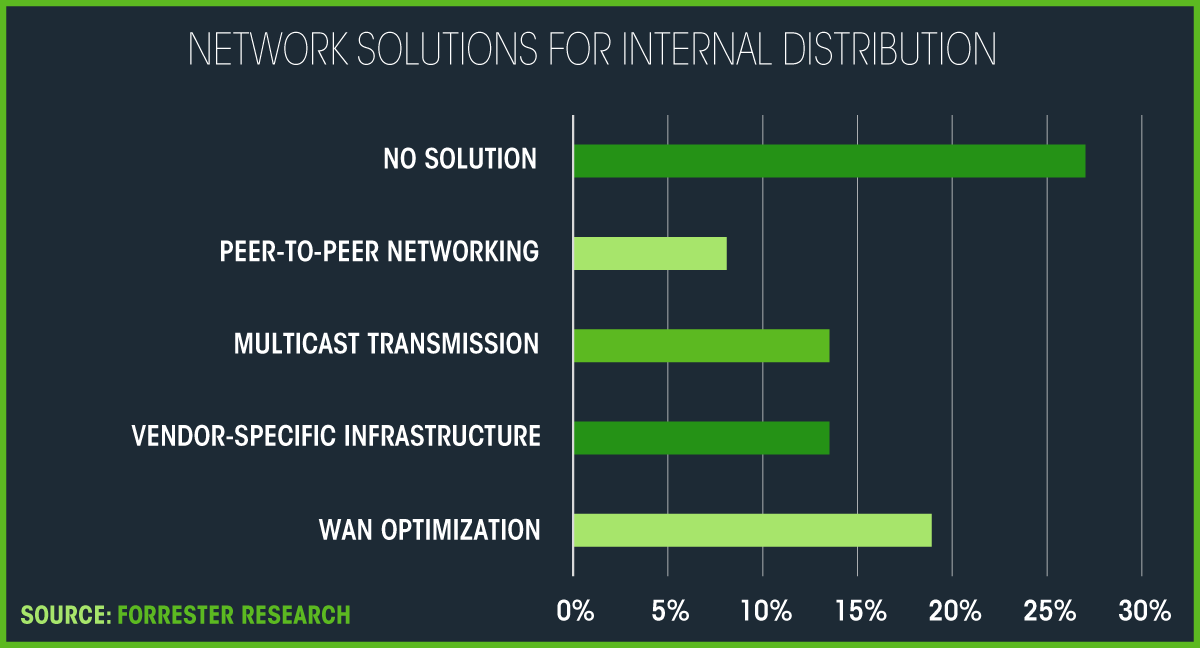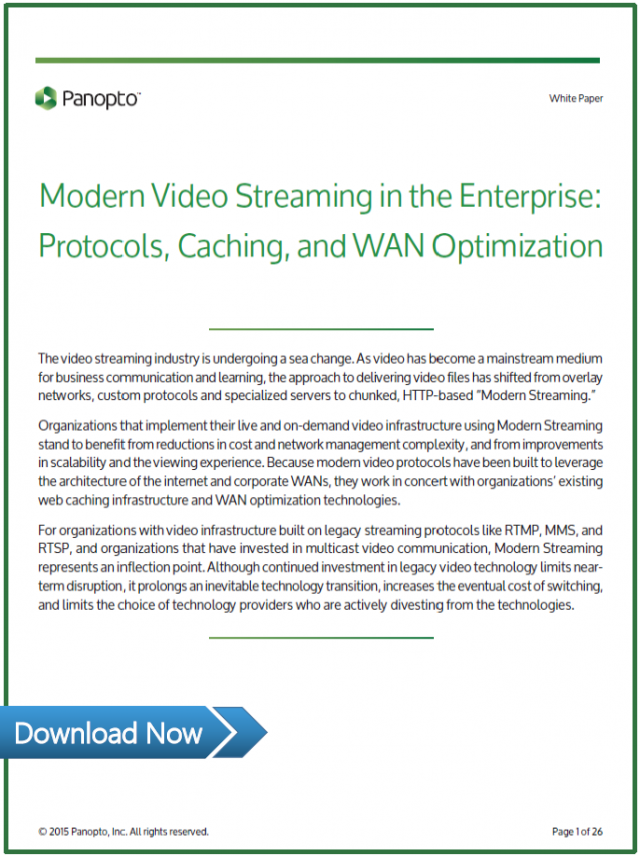- Communications
Beyond the Tipping Point: How Businesses Leverage Video Streaming Technology
Across enterprises today, using video in the workplace is becoming the norm. For every person in an organization, the application varies: salespeople use video to reach out to contacts and customers when they can’t meet in person, executives use video to communicate earnings results and reorganizations, and employees use it to get up-to-speed and share their expertise with their peers.
It seems that, in one way or another, everyone is taking an interest in video. Forrester Research recently published a report based on references from leading companies that are using enterprise video platforms to accomplish one or more of any number of tasks, including those listed above. What Forrester found was that while interest in video is ubiquitous throughout organizations, implementation is most often fragmented across subsidiaries, departments and job function use cases.
Forrester suggests that companies that have piloted video now have an opportunity to develop comprehensive video strategies, leveraging maturing enterprise video platforms. These video content management systems, which can integrate with content and learning management systems, handle recording, editing, storage and distribution of video inside and outside the corporate environment.

Enterprise leans heavily on video to communicate with both potential customers and employees, making video available both in real-time and on-demand.
Companies Are Getting More Sophisticated About Planning and Distributing Video Both Internally and Externally
Enterprises are using video to communicate with a host of stakeholders both external and internal. For each audience group, Forrester found that most customers were both broadcasting live and making videos available on-demand. For customer- and other external-facing video, live video was slightly more popular, while on-demand video was preferred for employee and internal-facing video content.
With no shortage of social media platforms and white-labeled video hosting services, companies have traditionally distributed their customer-facing videos on sites like YouTube and other hosting services. While public video websites like YouTube are effective for distributing video tutorials, advertisements and archived webinars, they present a number of issues for the vast majority of companies that need to protect intellectual property and trade secrets contained within their video content.
For internal video, companies often still feel forced to turn to traditional file storage with links from enterprise social and collaboration networks to actually share video content. Modern enterprise video platforms have sophisticated security and permissions tools that make sharing confidential video with select internal audiences possible. Forrester found that even companies operating in highly regulated environments are increasingly moving to these cloud-based systems, allowing individuals to record, upload and even webcast video from any device.
Companies are increasingly making video recording and posting available to all employees through enterprise video platforms.
Related Reading: Untangling the Complexities of Enterprise Video Streaming To Meet Growing Demand
Enterprise is, For the First Time, Opening Up the Production of Video — and the Sharing of Knowledge — to All of Their Employees
A second significant consideration that Forrester identified as a trend for customers deploying enterprise video is the rapidly rising importance of employee access to video recording and sharing tools inside the workplace.
Traditionally, video has been the purview of creative and media services departments, with teams of videographers, producers and editors managing the production process from beginning to end. While video hosting solutions sometimes allowed companies to create a portal for their employees to consume video, they typically don’t provide a way for employees to record and share their own video content with their colleagues.
Increasingly, corporations are realizing that the production of video need not be kept under lock and key. Employees, who often use video in their personal lives to chat with friends and preserve family moments, are eager to create and share knowledge at work too. And leading companies are embracing this desire.
By providing video-based social learning software, corporations can leverage their employee’s expertise in a way that can be saved for later use, whether that’s two weeks or two years later. This is especially effective in capturing the institutional knowledge of outgoing employees and the subsequent onboarding of new team members to take their place.
Today, more than 32% of companies surveyed in Forrester’s report allow all employees to post video, with more intending to do so.

While many companies have yet to address the demand video creates on their network, WAN Optimization and Modern Streaming are emerging as the clear way forward.
Companies Are Producing and Consuming More Video Than Ever. How Can IT Professionals Ensure Corporate Networks Keep Up with Demand?
Video now makes up more than 57% of all Internet traffic. That’s little surprise to anyone who has enjoyed a movie at home with Netflix or watched a YouTube video while on the go.
But video is rapidly flooding corporate networks, presenting a major technical challenge for IT professionals. Gartner predicts that by next year, the average employee will stream over 16 hours of video each and every month.
Over the years, vendors have offered no shortage of technologies to help their customers deliver video across an intranet. With fragmentation and long-term uncertainty about the technical delivery of video across networks, it’s no wonder more than 25% of businesses surveyed in the Forrester report had yet to implement a network solution to support the growing use of video.
 Fortunately, out of the noise of legacy video protocols and the confusion of evolving network infrastructure requirements, a clear answer is emerging. Modern HTTP-Based Streaming presents a series of new opportunities for organizations to use existing network infrastructure for more scalable, cost-effective video delivery, and may just be the key to helping today’s organizations keep pace with the rapid rise of video in the workplace.
Fortunately, out of the noise of legacy video protocols and the confusion of evolving network infrastructure requirements, a clear answer is emerging. Modern HTTP-Based Streaming presents a series of new opportunities for organizations to use existing network infrastructure for more scalable, cost-effective video delivery, and may just be the key to helping today’s organizations keep pace with the rapid rise of video in the workplace.
To learn more about the latest trends in Modern Streaming and network optimization, download a free copy of our white paper: “Modern Video Streaming in the Enterprise: Protocols, Caching, and WAN Optimization.”
Enterprise Video is Prepared to Makes Waves
By holistically examining enterprise video strategy utilizing a video content management system like Panopto, organizations can better manage their institutional expertise, market to potential customers across the Internet, and help salespeople reach their goals, all without sacrificing security or cannibalizing network bandwidth.
To learn more about how Panopto video platform can help your business unlock the potential of enterprise video, contact a member of our team to request a free trial today.



